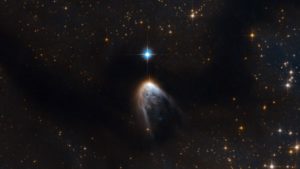The European Space Agency (ESA) announced in March that the Hubble Telescope had picked up a fascinating image of the birth of a new star, currently identified as IRAS 14568-6304. The photo they posted is shown below. The new star is the bright spot at the top of the gold glow (not the bright one above it).

I think the scientists must have been very excited—they managed to make their announcement quite poetic:
Like a hatchling pecking through its shell, this particular stellar newborn is forcing its way out into the surrounding universe.
This discovery is just one of many to come out of international cooperation in the field of astrophysics. The Hubble is managed by the European Space Agency, and the Infrared Astronomical Satellite that first identified the new star is a joint project of the US, the UK and the Netherlands, launched in 1983 to make the first all-sky infrared survey from space.
The ESA reported that if our eyes could register the faint infrared glow of the gas in the cloud, it would stretch across our sky more than 70 times the size of the full moon. It contains enough gas to make 250,000 stars like the sun.
The new star is one of several in the Circinus molecular cloud complex. It is ejecting gas at supersonic speeds and eventually will clear a hole in the cloud, allowing it to be easily visible to the outside universe. IRAS 14568-6304 is just the first among a number of sibling stars to break out of its parent cloud. The dark swath running across the image is the Circinus molecular cloud. The cloud is 2280 light-years away and stretches across 180 light-years of space. At longer infrared wavelengths, this darkness is filled with point-like stars that will one day break out like their big sister.
It is such a breath of fresh air to see international cooperation yield exciting results. I wonder what our world would be like if we elected scientists instead of politicians.
ESA/Hubble & NASA Acknowledgements: R. Sahai (Jet Propulsion Laboratory), S. Meunier